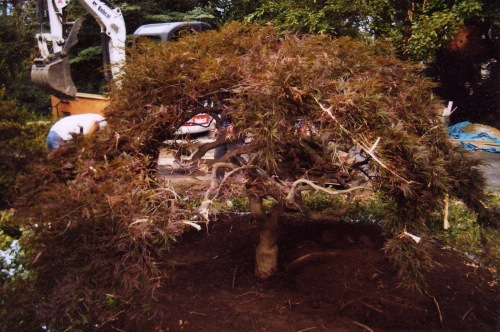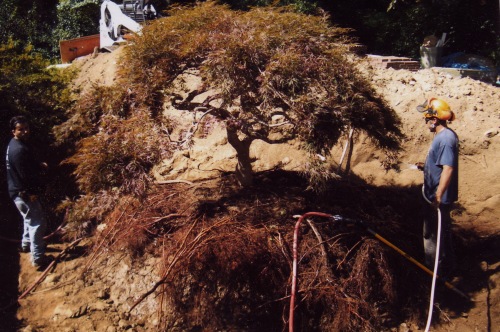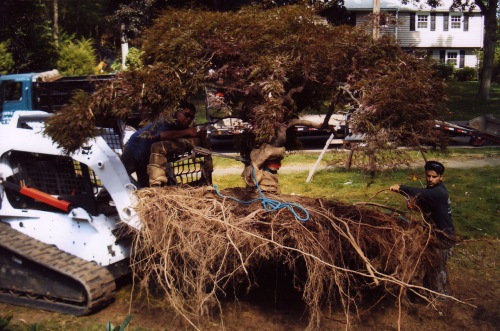Posted on Taking Place on July 1, 2009:
A few posts back I mentioned my February 2009 article in Lawn and Landscape Magazine on bare-root tree transplanting using an air spade. That article was preceded by my December 1, 2008 article in American Nurseryman, in which news of the technique debuted. Both articles describe the workshop at which several trees — a Juniperus virginiana, a couple of Acer palmatum, a couple of Betula pendula ‘Gracilis’, among others — were spaded and moved. Both articles outline how to carry out the process, though the Lawn and Landscape article is a bit more explicit. And they compare the merits of different methods of transplanting (tree spaded, ball & burlap, and air spade), including how cost, speed of operation, and effect on tree health may vary.
The beauty of using an air spade to transplant specimen trees is that so much root mass can be preserved and moved with the tree. The following photos of a dwarf Japanese maple (Acer palmatum dissectum), lent by Matt Foti, illustrate just how effective at saving roots this technique is.
Matt and his crews are using an air spade routinely now in transplanting work, because it preserves the tree’s resources so well, minimizing transplant shock and easing re-establishment. They moved this tree in early September of 2008. Take a look:

Acer palmatum dissectum awaiting its move. Soil under the tree has been lightly spaded to check surface roots.

Same tree, roots now exposed by the air spade. Note how far beyond the tree's dripline these roots extend.

Tree being lifted up for the move. The crew has wrapped its trunk and main limbs, to avoid injury; guy lines insure that it won't tip in transit.

Wrapping thoroughly during this kind of move lessens the chance of bark injury.

Tree in its new location, backfilled and awaiting thorough watering. No staking is necessary, as most of the root plate has been preserved and will continue to support the tree in its new home.
I have a question regarding transplanting a Crimson Frost River Birch with an Air Spade. In our area, River Birch do not transplant B&B in the fall very sucessfully. What do you think the prognosis would be barerooting?
Hi, Mark — Birches are generally considered a fall digging hazard, as you know. If you saw the American Nurseryman or Lawn and Landscape articles, you will know that Matt Foti and Mike Furgal showed that moving a birch with air tools on a hot August day was possible, though a tree dug in the conventional way on the same day wilted almost immediately. In fact, Matt will tell you that the next spring he was stunned by the lush growth he saw on the birch they had blown out; in a block of 7 or 8 other birches, it was a real standout for good growth and deep green foliage. If you haven’t read the articles, it’s worth clicking on the links I’ve put in this blog post, so you can.
If you have done air tool transplanting, you may have your own methods. If not, be aware that a move like this may work best if you don’t blow all the soil off all the roots; try blowing off the outer third of the root diameter, and then blow underneath the remaining root mass to un-anchor it from the ground. Then lift the soil slug, with the inner 2/3 still encased in soil and the outer 1/2 freed from soil, to give yourself a bit of an insurance policy for the move. Matt and Mike have found that blowing all the soil off can be a tricky proposition, and until someone does a controlled and larger-scale by-species experiment, using this hybrid method will help insure that your trees move and reestablish well. Fibrous-rooted trees tend to do very well; trees with tender bark (magnolias, for example) can suffer from the high air pressure, as it’s easy to blow the root bark off with the soil unless you’re very careful.
If you do go ahead and move the river birch this fall, take photos and send them over; I’d be delighted to hear how it goes, and would be happy to write a post about the move. Best of luck.